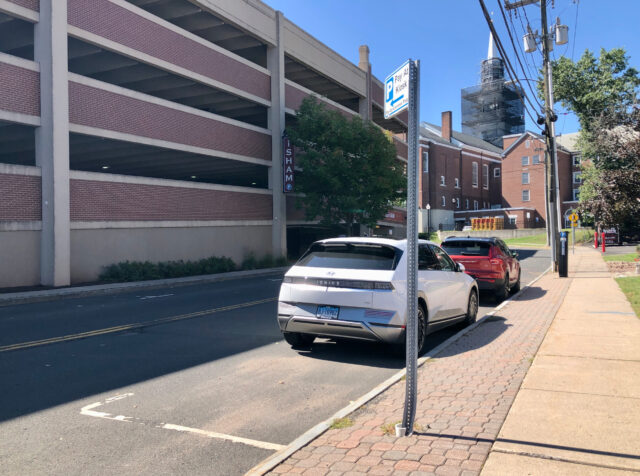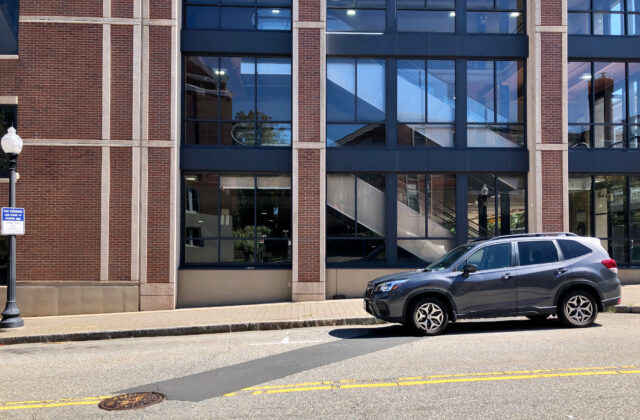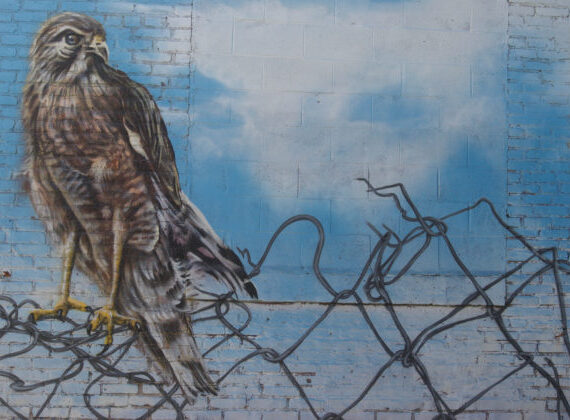Tomorrow (September 15, 2023) is PARK(ing) Day, something Hartford participated in a couple of times about ten years ago and then ceased to, perhaps prematurely.
The origins of this day were fairly subversive. It began in 2005 in San Francisco with people renting parking spaces and filling them with something other than cars. As long as someone is feeding the meter, it should not matter if it’s a car or a couch that goes into that spot. Doing this highlights what parking is: storing private belongings in the public realm. It shows other ways this space can be used, helping those who struggle with imagination to actually see it. And once you do, you can’t unsee it.
In a manifesto, the originators of this event say that the “parking space became a zone of potential, a surface onto which the intentions of any number of political, social or cultural agendas could be projected. By providing a new venue for any kind of unmet need, re-valued parking spaces became instrumental in redefining ‘necessity.’ Thus the creative act literally ‘takes’ place—that is, it claims a new physical and cultural territory for the social and artistic realm.”
The photos in this post were taken in West Hartford’s Blue Back Square/Center in 2023. They illustrate how parking is an uninspired use of space. There’s nothing in these shots that says the town has vibrancy or culture. A car-centric culture is not the kind of culture I’m talking about. These pictures show on-street parking right next to a parking garage. Why would you ever? A failure of imagination. A distorted philosophy of what is a necessity.
During PARK(ing) Day, a space might be a fortune teller’s booth or a tiny yoga studio or an outdoor library. It could be a place for finger painting. Lounging. Playing instruments. Eating lunch that you brought from home. A micro-playground could go in the spot. Not as fantastical, but it could shift from car parking to a corral that holds numerous bikes; it’s still storing private possessions in public space, but it makes a point about efficiency.
What happens on PARK(ing) Day is that people enjoy themselves. Some of this is just through discovering what new use of space is around the corner. Some is genuine interest in whatever activity is taking shape in the spot. It’s a break from routine. It’s feeling a ghost space come alive.
It’s a fairly simple concept that does a lot, including planting seeds.
Once you see a space can be active, engaging, and fun, it’s hard to make the case for returning all of it to what has become its standard use. It’s especially hard to make that case in Hartford where we have surplus parking citywide.
When Hartford had PARK(ing) Day, it was a sanctioned and organized activity. This was good and bad. It meant being able to hit it out of the park on the first go because there was funding that makes possible event organizing, involving artists without total exploitation, and getting the go ahead from the parking authority. . . or if not the go ahead, ability to manage them enough to leave the event alone for the day. At the same time, because this was not coming up out of the community, there wasn’t the same drive to make it happen after its short stint.
This is not a nostalgia piece.
While it would be nice to see again — we still have artists and other creative thinkers who would do a fabulous job of it — PARK(ing) Day is less necessary in Hartford than in some of our surrounding towns. Since then, we’ve gotten Pratt Street opened to people. Cars can neither drive nor park there, unless unloading, and then they must be chaperoned by the HBID Ambassadors like god and nature intended. Pratt Street has transformed from a dead zone to a venue for salsa dancing, music concerts, craft fairs, cornhole games, and a safe place for relaxing with friends. It’s unlikely this shift would have happened had people not been invited to imagine something different from the old norm, and it’s important to note that Hartford did not wake up one morning and decide to make the street off-limits to cars out of nowhere. Advocates had asked for this. And then, the people with power experimented. They tried the people-only street model for an event here and there. Then, they took a mile. (Not literally. Pratt Street is only 0.1 mi.) Then, for a few hours around lunch time on weekdays and longer on Fridays. And then, it happened. People saw that banning cars from one street did not cause the collapse of civilization. In fact, this boosted foot traffic on the street immensely. What reason did they have to go back to it being an automobile street? None. Not one.
Since then, we’ve gotten a few Open Streets festivals the last couple years in different sections of the city. This was something, too, that advocates requested. People seem to enjoy them. People get downright nasty when they see one announced for a neighborhood that is not their own; they calm down when told how one planned the following month or month after will be nearby. It’s a lot like speedhumps. Put one on a street and the people on the parallel street want to know when their’s is coming.
Forward motion is not inevitable though.

Progress is not a straight line. Just look at how we’ve seen improvements undone in Hartford (for no compelling reason allowing people to drive into most parks again, changing the parts of Trumbull Street and Allyn Street from patio back to motor-palooza). At least 22% of downtown Hartford is parking. Still.
Over the line in West Hartford there has been backwards motion, like changing LaSalle from one-way back to two-way which makes it more difficult for pedestrians to cross, and I’ll be kind and stop there for examples. West Hartford’s Vision Zero’s Task Force is soliciting opinions — this is not limited to residents — via a survey and interactive map, which will be open through October 3, 2023; what becomes of this feedback is another matter. It’s a question of where people feel safe, where they don’t, and what they think is needed to improve the streets.
West Hartford has dipped its toes in the water with Center Streets, making the town center significantly safer and more pleasurable to experience on foot and bicycle . . . for several hours on exactly one day of the year, and while the town’s government has to cooperate for this to happen, the organizing for it comes from Bike West Hartford — a mobility advocacy group comprised of volunteers. Over the last year, they’ve definitely come into their own, and it would be nice to see them experiment with something like PARK(ing) Day in a future year, perhaps if their volunteer numbers expand. There was instant government support for converting street space to outdoor dining as a way to help out restaurants, but livable community advocates so far have had a tough time selling the idea of making similar changes for reasons other than money, money, money. An event like PARK(ing) Day can help build the case. People like to hang out, have fun, socialize. When they see other ways to do this, it may make it harder for town decisionmakers to drag their feet.
Like many other places, far too much of West Hartford’s space has been given over to parking. We’ve seen some lots temporarily repurposed. Part of the mall’s surplus parking was used for a circus tent recently and farmers’ markets are held on lots in the town center, not to mention how various churches and synagogues converted their lots into outdoor sanctuaries during pre-vaccine pandemic. We’ve seen that the world does not stop spinning when space used for car storage is given other purposes. So, what is the delay in making even half of those changes permanent?
From my experience of being (too) involved in trying to make places genuinely nicer for people to live in over the years, funding is often blamed for inaction, but the real reason is an absence of political will. Often those making decisions are going to do what will get them yelled at the least by constituents. We can fix this by demanding government employees be willing to do what is right, but also by helping those constituents see that there are so many more ways of being than they might realize. Not everyone summers on car-free islands or can make expensive trips through cities worldwide that have prioritized quality of life. We can be mad that these folks don’t know, or we can show them alternatives. PARK(ing) Day is a low-stakes and temporary way to do that.
Climate Possibilities is a series about climate mitigation, along with resilience, resistance, and restoration. It’s about human habitat preservation. It’s about loving nature and planet Earth, and demanding the kind of change that gives future generations the opportunity for vibrant lives. Doomers will be eaten alive, figuratively. All photographs are taken in Hartford, Connecticut unless stated otherwise.



Tim Wolf
As I read this I thought, what if tomorrow, on Park(ing) Day, I plunked down in a chair or placed my person or some possession in a parking space downtown and paid for the time. The only way to pay to park is by entering a license plate number in a parking kiosk or through the Woonerf app. So before I could even begin to “park” I would be subverted. I can just imagine a Parking Authority employee, a cop or a belligerent driver hassling me and I wouldn’t have proof of having rented the space. This is just my musing on a fantasy of actually try to participate in Park(ing) Day.